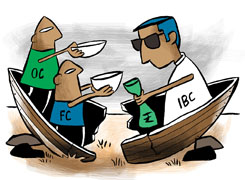Stressed with Multiple Loans and Credit Card Bills - Seeking Advice
Ramalingam Kalirajan |10899 Answers |Ask -Follow
Mutual Funds, Financial Planning Expert - Answered on Mar 13, 2025
He has an MBA in finance from the University of Madras and is a certified financial planner.
He is the director and chief financial planner at Holistic Investment, a Chennai-based firm that offers financial planning and wealth management advice.... more

Sir i have multiple loans and credit card bills which sums up 20 lakh and my monthly income is 30k i am not able to pay the emi anymore on time every month i am in deep stress in trying to pay the emi plz help
You are not alone. Many people face similar financial struggles. With the right steps, you can come out of this stress.
Assess Your Debt Situation
Total loan and credit card debt: Rs 20 lakh.
Monthly income: Rs 30,000.
EMIs and credit card bills are unmanageable.
Stress is increasing due to financial burden.
The first step is to stop taking new loans or using credit cards.
Prioritise Your Debts
Credit card debt has the highest interest (30-40% per year).
Personal loans have high EMIs and penalties for delays.
Secured loans (home, car) should be managed to avoid asset loss.
Focus on clearing high-interest debts first.
Negotiate with Banks and Lenders
Contact your bank and request a loan restructuring.
Ask for a lower EMI with a longer repayment period.
Request a moratorium (temporary pause on EMI) if needed.
Convert credit card dues into an EMI loan with a lower interest rate.
Negotiate for a settlement if repayment is impossible.
Banks prefer to restructure loans rather than declare them as defaults.
Debt Consolidation Options
If you have a low-interest secured loan option (like a gold loan), consider using it to clear high-interest credit card debt.
Avoid taking another personal loan to clear old debts. It will worsen your situation.
Increase Your Income
Look for part-time or freelance work for extra income.
If possible, sell unused assets (bike, gadgets, jewelry) to reduce debt.
Discuss with family members for temporary financial help.
Cut Unnecessary Expenses
Reduce spending on non-essential items.
Stop using credit cards immediately.
Follow a strict budget and use cash or debit cards for expenses.
Seek Professional Help
A Certified Financial Planner (CFP) can help create a repayment plan.
If stress is overwhelming, consult a financial counselor or mental health professional.
Final Insights
Your situation is difficult, but a step-by-step plan will help.
Stop new loans and credit card usage immediately.
Contact banks to negotiate for lower EMIs or settlement options.
Increase income through extra work and reduce expenses.
Seek guidance from a Certified Financial Planner.
You are not alone. With the right approach, you can come out of this financial struggle.
Best Regards,
K. Ramalingam, MBA, CFP
Chief Financial Planner,
www.holisticinvestment.in
https://www.youtube.com/@HolisticInvestment
You may like to see similar questions and answers below
Milind Vadjikar | Answer |Ask -Follow
Insurance, Stocks, MF, PF Expert - Answered on Feb 27, 2025
Ramalingam Kalirajan |10899 Answers |Ask -Follow
Mutual Funds, Financial Planning Expert - Answered on Jun 21, 2025
Ramalingam Kalirajan |10899 Answers |Ask -Follow
Mutual Funds, Financial Planning Expert - Answered on Jun 26, 2025
Ramalingam Kalirajan |10899 Answers |Ask -Follow
Mutual Funds, Financial Planning Expert - Answered on Dec 17, 2025
Ramalingam Kalirajan |10899 Answers |Ask -Follow
Mutual Funds, Financial Planning Expert - Answered on Dec 17, 2025
Ramalingam Kalirajan |10899 Answers |Ask -Follow
Mutual Funds, Financial Planning Expert - Answered on Dec 17, 2025
Ramalingam Kalirajan |10899 Answers |Ask -Follow
Mutual Funds, Financial Planning Expert - Answered on Dec 17, 2025
Ramalingam Kalirajan |10899 Answers |Ask -Follow
Mutual Funds, Financial Planning Expert - Answered on Dec 17, 2025
Mayank Chandel |2576 Answers |Ask -Follow
IIT-JEE, NEET-UG, SAT, CLAT, CA, CS Exam Expert - Answered on Dec 17, 2025
Radheshyam Zanwar |6747 Answers |Ask -Follow
MHT-CET, IIT-JEE, NEET-UG Expert - Answered on Dec 16, 2025
Shalini Singh |181 Answers |Ask -Follow
Dating Coach - Answered on Dec 16, 2025
Patrick Dsouza |1429 Answers |Ask -Follow
CAT, XAT, CMAT, CET Expert - Answered on Dec 16, 2025
Nayagam P P |10858 Answers |Ask -Follow
Career Counsellor - Answered on Dec 16, 2025

























